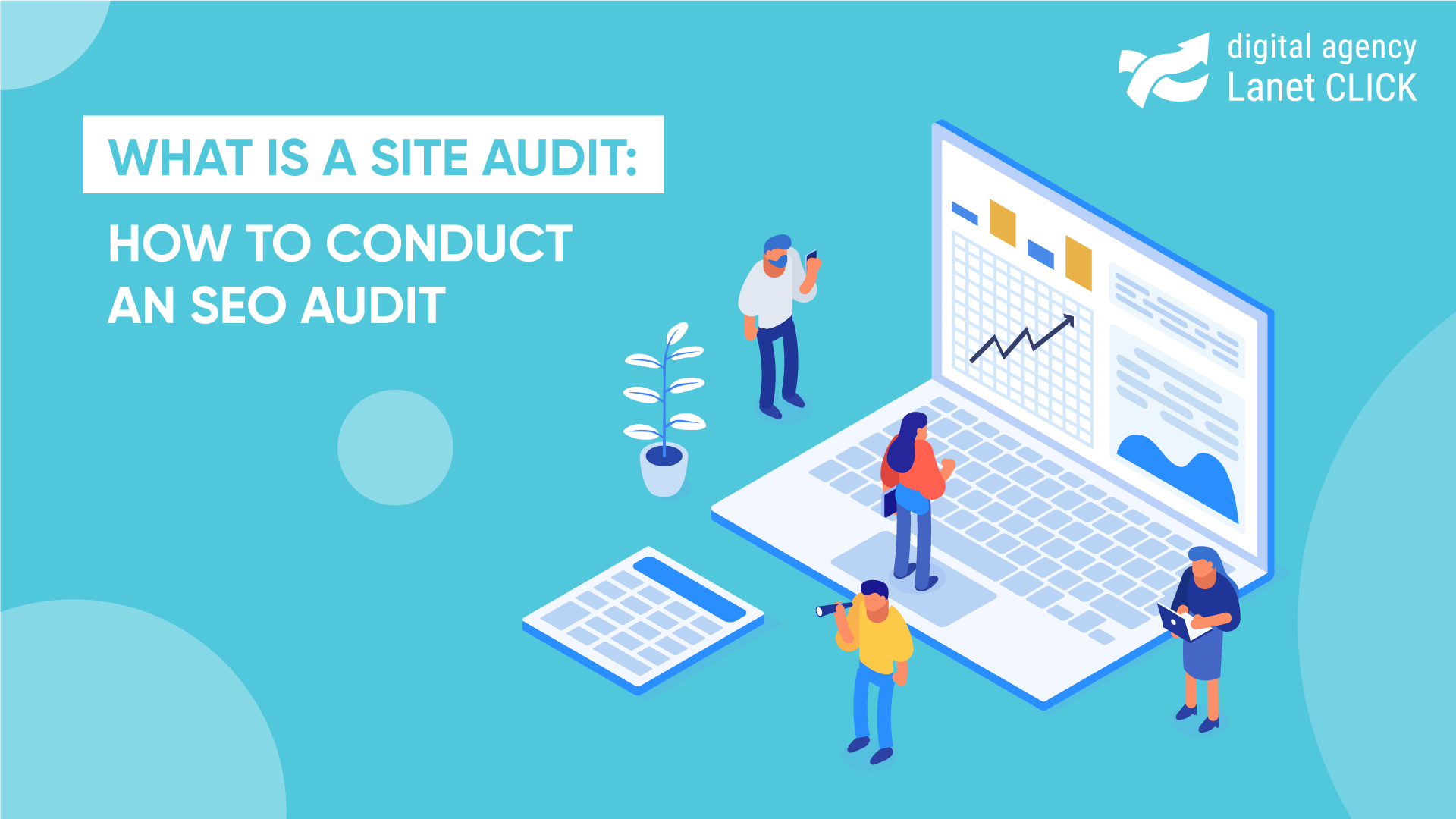A site audit is checking your site for compliance with Google’s requirements and the absence of errors. The SEO analysis of the site is the starting point before the start of the comprehensive promotion. It is necessary for any site, regardless of whether it is a new site or has already advanced.
A site audit can be:
- search (optimization of the site by search engine queries);
- technical (analysis of software features of the site);
- content analysis (how unique and high-quality the content is);
- usability analysis (how user-friendly the site is);
- checking and preparing landing pages (creating or changing titles, descriptions, and page header tags).
An express audit can be selected separately. It is a surface analysis of the site when a specialist evaluates the degree of preparation of the site for promotion and points out the most critical errors.

The benefits of an SEO audit
A competent audit will allow:
- Analyze the technical condition of the site. Over time, errors appear on any site, such as duplicate pages, slow loading speed, incorrectly configured redirects, etc. The audit will provide an opportunity to identify all problems and quickly correct them.
- Check whether the structure of the site meets the requirements of search engines. Site structure refers to the layout and connection of site pages. It directly affects the ranking and indexing of the site. And by conducting an audit, you can identify errors related to the structure of the site and quickly eliminate them without losing positions in search results.
- Find the points of growth of search traffic. If you feel you’ve done everything you needed in terms of SEO but still haven’t gotten any traffic, try doing an audit. In this way, you will be able to identify new points of growth and draw up an actual plan for improving indicators.
- Verification of SEO specialists. An SEO audit will help you check the quality of services if you work with an agency or an individual contractor engaged in site promotion.

What do you need to pay attention to when conducting an audit
Before conducting a site audit, it is necessary to go through the initial preparation stage. It is convenient to do this with the help of a special search robot or web crawler. Thanks to it, you will be able to analyze the code, content, external and internal links, and other elements of SEO. After completing the initial processing stage, proceed to the SEO analysis and pay attention to:
- Robots.txt and meta tags robots. The Robots.txt file is placed in the root directory and contains instructions for search engines. Thanks to Robots.txt, you will be able to:
- allow robots to index only the specified pages of the site or prohibit their viewing at all;
- reduce the load on the site from search robots;
- show the robots which mirror of the site is the main one if there are several of them;
- specify the URL of the sitemap files.
- XML Sitemap. The sitemap is located in the root directory and tells search engines which of the pages should be indexed first and how often it is updated. In cases where there is a Sitemap on the site, during the audit it is necessary to check how correctly it works. If the file contains more than 50,000 URLs and its weight exceeds 10 MB, it is better to split one file into several sitemaps. If you don’t have a sitemap file, use one of the XML Sitemap tools or similar to work. After the process is complete, perform additional Sitemap analysis and inform search engines about its creation.
- Assessment of site indexing quality. It is conducted to understand how well the site is indexed or whether it has fallen into a shadow ban. For this, you need to enter the operator site with the domain name without a search query, for example, site: lanet.click. Thus, in the audit process, you will be able to compare the number of pages that are indexed with the total number of pages of the network resource.
- HTTP status codes. The HTTP status code indicates whether the HTTP request was successfully completed and is a three-digit Arabic number. Code 404 means that the page was not found. To avoid 404 situations, remember to check HTTP status codes regularly.
- Site page URLs. A competent URL should contain no more than 150-200 words that are easy to read. Ideally, the URL should include keywords that match the page’s content. It will improve indexing and provide more convenience for users.
- Site loading speed. Users often close sites if they see that they are loading slowly. After the audit, you may find out that the site needs to speed up. Try to optimize the image or reduce the redundant code.
- Site architecture. Check that each of the site’s pages has a clear structure and that everything is in order with each other. If the site has a more logical structure, it is easier for the user to find the necessary information, and it is better for robots to index the site.
- Internal links. For the link to be successful, it is enough to follow simple rules:
-
- don’t use anchor keywords exclusively. It is preferable to use two types of keywords: targeted and neutral. In this case, the total number of links will look more natural;
- the keywords must be relevant to the network resource.
- do not post many links on one page;
- make sure anchors point to pages that should be indexed first.
- Page titles. Titles are the important elements of the site, so they should not be missed during the audit. Most users decide whether to visit the site or not based on the titles. Keep it under 90 symbols, be unique, and include keywords. It’s important to remember that titles are intended for users, not robots.
- Page description and keywords in tags. The description of the pages from the tag has every chance of getting into the snippet in the search results, so it should also be treated carefully. It shouldn’t exceed 150-160 symbols and talk about the content of one page but not the entire site. The main thing is not to forget to update the information during each audit constantly.
- The presence of micromarking. It is the markup of data on the site designed to help search engines better recognize the content. With its help, you can show that certain text or other elements are more important than others.
- Content. Make sure that the texts on the page contain useful and unique information. Don’t focus too much on optimization because, like titles, content is for people. If even the text is unique, but with an excess of keywords, the audit process will reveal that this was not reflected in the SEO promotion or reduced its quality.

Special attention should be paid to duplicate content. If your site or other pages have the same content, search engines need to be told which page to index. Most often, duplicate content occurs because:
- the website’s CMS allows you to access the same pages from different links;
- the content is stolen and published on new pages without indicating the original source.
Duplicate content is detected by dedicated servers and is very easy to remove. For example, use the directive rel=”canonical”.
- Images. Images are an effective SEO promotion tool. They can become a source of additional traffic and improve the site’s behavioral factors. The main thing is to optimize images correctly. It should be:
- high quality, suitable size and resolution
- be displayed equally on all devices;
- contains the attributes “alt” and “title”.
- Link profile analysis. It involves checking the quality of incoming links to the site. In the audit process, the donor quality on which the link is placed is evaluated, and the sheet anchor is analyzed for density, naturalness, and spamming.
- Availability of a mobile version. The majority of people now visit websites precisely from a smartphone. Therefore, in the audit process, it is important to check the quality of the mobile version of the site and its loading speed. If it is not there, there are 2 options: to create an adaptive layout or a PDA version. An adaptive layout means the site has two versions: one for desktop visitors and one for mobile devices. In the case of PDA, the mobile version will be on a separate subdomain.

Useful services for auditing
It is very convenient to check the SEO of the site with the help of special services. Among the most popular services that will help you understand how to do an SEO audit of a site are:
- Screaming Frog. An irreplaceable audit tool will tell you everything about your site and help generate a sitemap. With its help, you can detect any technical problems.
- Ahrefs is a service designed primarily for external site optimization analysis. It will help site owners and SEO specialists find the main competitors, analyze the promoted page, identify the reasons for low ranking and improve the quality of search traffic.
- Google Search Console. A free Google tool that allows you to collect site performance data. Thanks to it, SEO specialists receive information about how Google analyzes, indexes, and displays sites in search results. With this information, you can optimize your site according to Google’s requirements.
- Majestic. A service that contains many useful tools for auditing. But its main tasks are external link analysis and URL research.
A regular SEO audit will increase your site’s ranking in search results and show where there are growth points and what should be worked on. Due to this, traffic to the site will increase significantly because users tend to return to convenient sites. Using an SEO audit, you can also provide a technical task for programmers to help improve your site.





